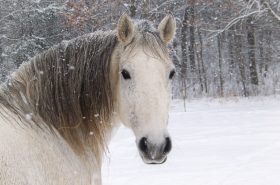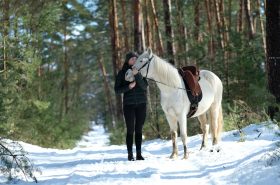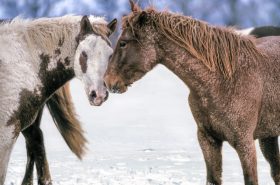A horse’s topline, which is the muscles located along the top of the neck, back, and
haunches, needs to be strong for optimum performance.
Horses with weak toplines are susceptible to injury and won’t move effectively. These muscles hold the spine in place while the horse moves forward off their hindquarters. Building a topline can be challenging for some horses. Exercise and genetics definitely
factor in when developing these muscles. Horse owners can stretch their horse, engage in various groundwork exercises, ride on hills, and incorporate polework. Genetics can also impact the horse’s topline. Many fail to factor in the importance of good nutrition though. Good or correct nutrition is necessary when developing muscles. It’s critical they receive protein with proper amino acids.
Feeding the Right Protein
Protein consists of chains of amino acids, which are the building blocks of muscles and tissues. While forage can meet the needs of a horse’s daily crude protein, it often lacks esse
ntial amino acids. These include lysine, threonine, and methionine. Even a high- quality forage may be lacking in this area. Many owners turn to a concentrate or ration balancer to supplement their horse. With fortified sources like soy, peas, and flax seeds, these feeds contain the essential aminoacids that your horse’s forage is lacking. This allows them to get the right nutrients for muscle development and repair. When feeding a concentrate, some run into the issue of their horse getting too many calories. The horse may become overweight or have too much energy. A ration balancer is often the answer in these cases. It offers the essential amino acids, but without the high calories. This is usually a great option for easy keepers or those overweight horses and ponies.
Minerals and Vitamins
Furthermore, a deficiency is certain minerals or vitamins can lead to poor recovery and muscle function. Some of the important ones for building a topline include magnesium, vitamin E, and selenium. A complete feed or supplement can be used to enrich the horse’s diet.
Digestive Health
Owners will also want to support digestive health. Seniors or horses with gastric ulcers will struggle with feed efficiency, which is their ability to extract nutrients from foods. A digestive health supplement can support your senior horse. They consist of probiotics, digestive enzymes, and prebiotics. Unfortunately, the treatment for gastric ulcers can raise the pH in your horse’s stomach. A low pH is needed to kill harmful microbes. This will likely affect your horse’s topline. You’ll need to restore the pH after the ulcers are successfully treated. Diet alone will not likely give your horse a strong topline, but it will greatly impact it. You can exercise your horse and see little results unless they have proper nutrition.



